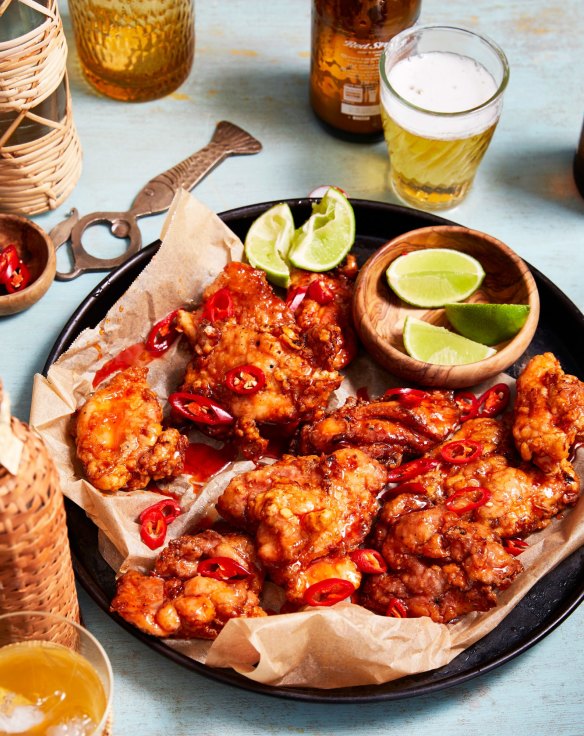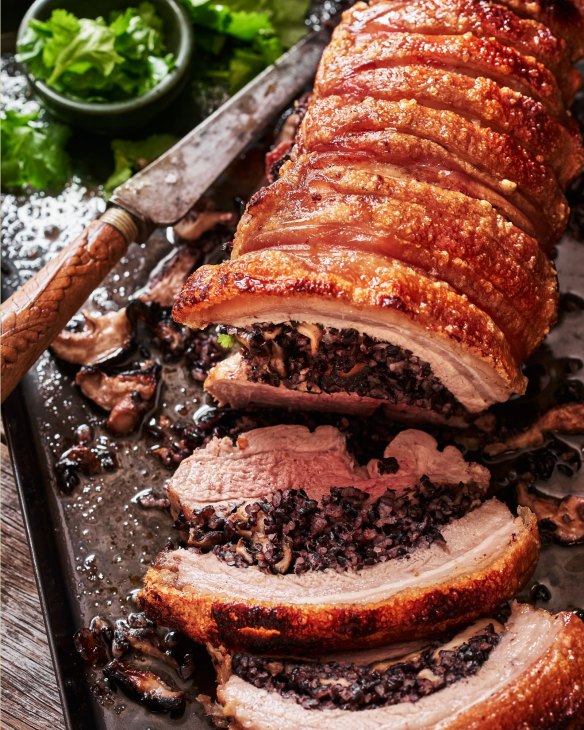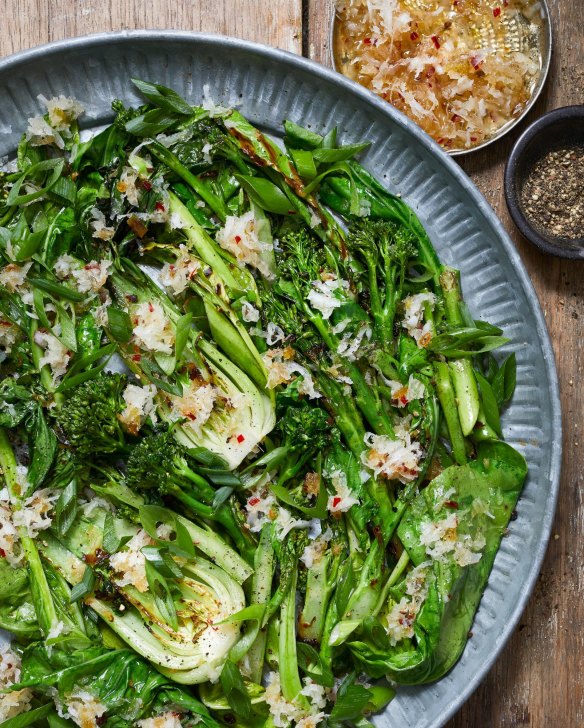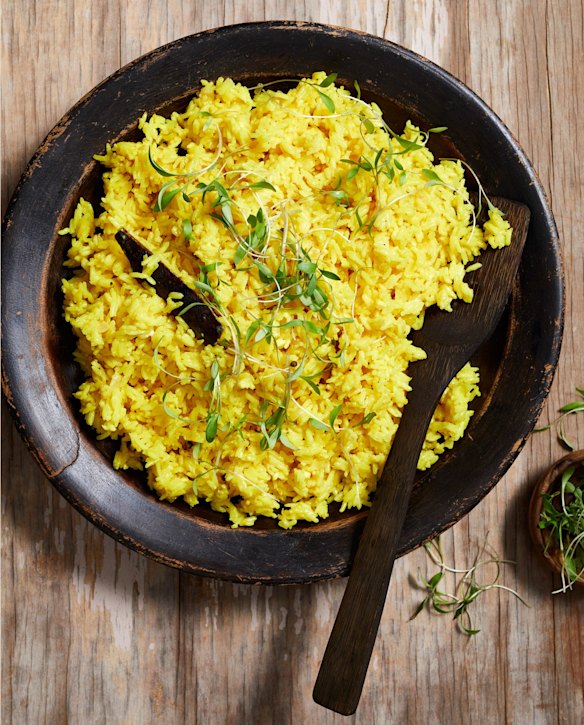Four family-style recipes for an easy Filipino feast at home

The period when Filipino food was little known outside its homeland is over, says food and travel writer Yasmin Newman.
Her new collection, Under Coconut Skies, explores the ins and outs of Filipino cooking, from the sweet, sour and salty combinations that make the flavours so enjoyable, to the herbs, teas and ubiquitous ginger and turmeric roots that provide nourishment and healing.
"It is a tribute to the cooking found in new restaurants in the Philippines and homes of other second-generation and young Filipinos around the world just like me, as we proudly shape, share and champion our cuisine," she writes.
Here, Newman shares four recipes to build your own Filipino feast.

Pritong manok (Fried chicken with banana chilli catsup glaze)
For us, fried chicken is the taste of happiness. It's memories of afternoon merienda (snacks) with friends and family dinners. It came into our consciousness in the early 20th century with the American occupation, when two fried chicken houses also emerged. Today, they characterise the two camps: crunchy Jollibee Chickenjoy or light Max's Restaurant-style. I chow into both, but when it comes to pulutan (beer food), a favourite food group in the Philippines, I can't go past the crust and shattering crackle of the former. As soon as it comes out of the oil, I plunge it in sweet and sticky banana catsup (ketchup) to glaze instead of serving it on the side, and douse it in kalamansi juice and fiery sili (chilli).
INGREDIENTS
- 1 red onion, finely grated
- 6 garlic cloves, finely grated
- 2 tsp sea salt
- 1 tsp freshly cracked black pepper
- 1kg boneless chicken thighs, halved, or mixed drumsticks, wings and thighs
- 75g plain flour
- 85g cornflour
- vegetable oil, for shallow-frying
- 5 kalamansi, halved, or 1 lime, cut into wedges, to serve
- 1 long red chilli, thinly sliced, to serve (seeds optional)
Chilli catsup glaze
- 160ml banana catsup (available from Filipino or Asian grocers)
- 150g caster sugar
- 80ml fish sauce
- 2 long green chillies, thinly sliced
METHOD
- Combine the onion, garlic, salt and pepper in a large bowl. Add the chicken and toss to coat well. Cover and set aside for 1 hour.
- To make the chilli catsup glaze, place the ingredients and 1 tablespoon of water in a large bowl and stir well to combine.
- Heat 1cm of vegetable oil in a large deep frypan over medium heat. Place the flour and cornflour in a large bowl, season with salt and pepper and stir to combine. Working in three batches, remove the chicken from the bowl, leaving the onion mixture attached, and coat well in the flour mixture, making sure it gets into all the creases and crevices – the more the better as these will form the crispy crunchy bits. Cook the chicken for 2-3 minutes each side, until golden and crispy (or 3-4 minutes each side for drumsticks and 1-2 minutes each side for wings). Drain on paper towel, then repeat with the remaining chicken.
- While the chicken is still hot, add to the glaze and toss to coat well. Transfer to a serving platter and squeeze over some of the kalamansi halves or lime wedges. Scatter over the chilli and serve with the remaining kalamansi or lime on the side for squeezing over.
Serves 4-6

Lechon liempo (Lechon with shiitake and black rice stuffing)
There are few greater pleasures in life than our whole roasted suckling pig known as lechon. Requiring hours of tender love and care – preparing, then turning over coals to ensure the skin is perfectly crisp and the meat is succulent and tender – it's the centrepiece of our fiestas and savoured from head to toe. When a whole hog is too much, there's our lechon liempo. Much like Italian porchetta, pork belly is rolled, then roasted with equally crackling-meets-juicy effect, whether over traditional flames or in the oven. In the home of the flamboyant Dedet de la Fuente, aka Lechon Diva, I was treated to her world-famous lechon stuffed with truffle rice – hands-down the best I have ever tried. Inspired by the perfume it lent the meat, along with the side of rice used as a stuffing, this is my version with black rice and shiitake mushrooms, made liempo-style for home.
INGREDIENTS
- 2kg skin-on boneless pork belly
- sea salt and freshly cracked black pepper
- 1.25L chicken stock or water
- 200g black rice
- 2 tbsp vegetable oil, plus extra for drizzling
- 200g shiitake mushrooms, thickly sliced
- 4 garlic cloves, finely chopped
- green salad leaves, to serve (optional)
METHOD
- Score the pork belly skin in straight lines at 1.5-2 cm intervals. Scatter the skin with 1 tablespoon of salt, then refrigerate overnight (this helps dry the skin for an extra crisp finish; optional if you're pressed for time).
- Bring the stock to the boil in a saucepan over high heat. Add the black rice and cook for 30 minutes to partially cook. Drain and set aside.
- Heat the oil in a large frypan over high heat. Add the mushroom and garlic and season generously with salt and pepper. Cook, stirring, for about 4 minutes, until golden. Remove from the heat, stir in the black rice and set aside to cool slightly.
- Preheat the oven to 160C fan-forced (180C conventional). Pat dry the pork belly skin using paper towel, then place skin-side down on a clean work surface. Butterfly the meat by slicing horizontally through the centre, stopping short of the end, then open to form one large piece.
- Season the pork flesh with salt and pepper, then spread the black rice mixture over the skin-side down half of the pork. Fold the flesh over the top, then, with a long edge facing you, roll up the pork away from you into a log (the skin should cover the outside of the roll). Tie at six intervals with kitchen string to secure firmly.
- Place a wire rack over a roasting tin and place the rolled pork belly on the rack, seam-side down. Rub with oil and season all over with salt. Roast for 1 hour 15 minutes. Increase the heat to 230C fan-forced (250C conventional) and roast for a further 30 minutes or until the skin is crackling and the meat is cooked through. Remove from the oven, cover loosely with foil and rest for 20 minutes before carving.
Serves 6-8

Charred greens with coconut and palapa oil
Researching 7000 Islands, very little was documented on the cuisine of the Philippines' far south and I was eager to learn and share more. It was through a friend in Manila that I got my first taste of the Maranao tribe's secret weapon: palapa, a condiment heavy with sili labuyo (chilli), ginger and sakurab, a spring onion (scallion) native only to Mindanao. You'll find grated coconut meat in some versions like mine here, adding scrumptious texture. In fact, palapa forms the base of most of their blazing dishes, including pindyalokan manok, rendang (beef curry) and phesasati-a-odang (prawn and coconut cakes). Really, it can be used with almost anything with delicious effect, and made ahead and stored in the fridge so it's ready for action. Tossed through warm Asian greens, it's a scintillating vegetarian dish.
INGREDIENTS
- 1 bunch bok choy, halved or quartered lengthways
- 1 bunch gai lan (Chinese broccoli), halved or quartered lengthways
- 1 bunch broccolini, halved or quartered lengthways
Palapa oil
- 250ml vegetable oil
- 1 bunch spring onions, white part thinly sliced, green part reserved
- 2 tbsp finely grated ginger
- 3 bird's eye chillies, deseeded if you prefer less heat, finely chopped
- 2 tsp caster sugar
- 2 tsp sea salt
- 80g freshly grated mature coconut
METHOD
- To make the palapa oil, place the oil, white part of the spring onion, ginger, chilli, sugar and salt in a saucepan over medium heat. Bring to a simmer, then reduce the heat to low and cook for 8 minutes or until the aromatics are tender and fragrant. Remove the pan from the heat, stir in the coconut and set aside until needed.
- Preheat a grill to medium-high. Line a baking tray with foil and add half the bok choy, gai lan, broccolini and spring onion greens in a single layer. Drizzle with 2 tablespoons of the palapa oil (without the coconut) and toss to coat. Grill, turning occasionally, for 3-5 minutes, until the greens are just tender, golden and lightly charred in parts.
- Transfer to a serving plate and repeat with the remaining greens. Drizzle with a little palapa oil (with the coconut) and serve.
- The remaining palapa oil will keep in an airtight container in the fridge for up to 1 week.
Serves 4-6 as a side

Kioning (Turmeric and cassia bark rice)
Not a meal goes by that's not served with rice, whether freshly steamed (kanin) or glistening with garlic and oil (sinangag). In the south, you'll often see it in yellow mounds, tinted and perfumed with turmeric – my eyes always gravitate to this beautiful sight. It's sometimes called Java rice, made famous by The Aristocrat Restaurant in Manila and owing to its similarity to Indonesian nasi kuning. Like much of the food throughout Mindanao and the Malay peninsula, the dishes are indeed related; kioning is the name given by the Maranao tribe, who shape their brilliant yellow rice into cone-shaped pyramids using banana leaves. It's variously enriched with lemongrass, cassia leaf or bay leaf, but this alluring version is scented with cassia bark and made creamy from evaporated milk. Make sure to use fresh turmeric – a far cry from ground when it comes to flavour. Once you try it, you won't want to make rice any other way again.
INGREDIENTS
- 2 tbsp vegetable oil
- 1 small red onion, thinly sliced
- sea salt and freshly cracked black pepper
- 2 garlic cloves, finely chopped
- 3cm piece of ginger, peeled, finely grated
- 4cm piece of turmeric, peeled, finely grated
- 1 cassia bark stick or ½ tsp ground cinnamon
- 500g jasmine rice
- 725ml vegetable or chicken stock
- 125ml evaporated milk, plus extra to serve
- micro coriander leaves, to serve (optional)
METHOD
- Heat the oil in a saucepan over medium heat. Add the onion, season with salt and pepper and cook, stirring, for 4 minutes or until soft. Add the garlic, ginger, turmeric and cassia bark or cinnamon and cook, stirring, for 1 minute or until fragrant and the oil is yellow. Add the rice and stir until well coated in the yellow oil.
- Add the stock and evaporated milk and bring to the boil, then reduce the heat to low and cook, covered, for 12 minutes or until the liquid is absorbed. Remove the pan from the heat and stand, covered, for 5 minutes or until the rice is tender.
- Pile the rice onto a serving platter or shape into individual mounds using a small bowl. Season with salt and pepper, drizzle over the extra evaporated milk and scatter with the micro coriander (if using).

Serves 6
This is an edited extract from Under Coconut Skies by Yasmin Newman, Smith Street Books, RRP $55.00. Food photography: Georgia Gold and Rochelle Eagle. Portrait photography: Camille Robiou du Pont. Buy now